#new york theatre review
Text
Theatre Review: Merry Me (New York Theatre Workshop) ★★★★
Playwright Hansol Jung and veteran Tony-nominated director Leigh Silverman reunite, following their collaborations on Cardboard Piano and Wild Goose Dreams, to create an evening of queer bliss with the hilarious lesbian sex comedy Merry Me running at New York Theatre Workshop until Sunday, November 19th. Jung’s new play brings together Restoration comedy, Greek theatre, and Shakespeare (one of…
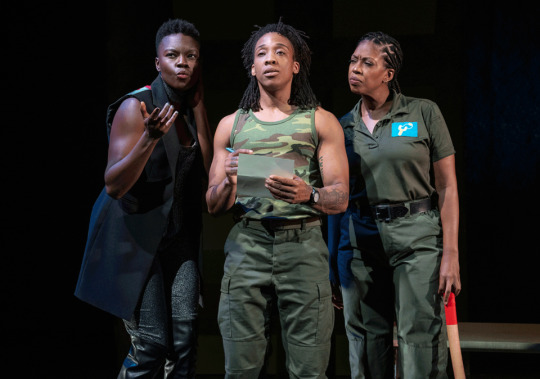
View On WordPress
#cindy cheung merry me#david ryan smith merry me#esco jouléy merry me#gay#hansol jung merry me#James Kleinmann#joan marcus merry me#leigh silverman merry me#lesbian comedy#lesbian sex comedy#lesbian thater#lesbian theatre#lgbt#lgbtq#marinda anderson merry me#merry me#merry me review#merry me the queer review#new york theatre review#new york theatre workshop merry me review#nicole villamil merry me#nytw merry me review#queer#queer female characters#queer play#queer theatre#queer women#Ryan Spahn#ryan spahn merry me#Shaunette Renée Wilson merry me
0 notes
Text
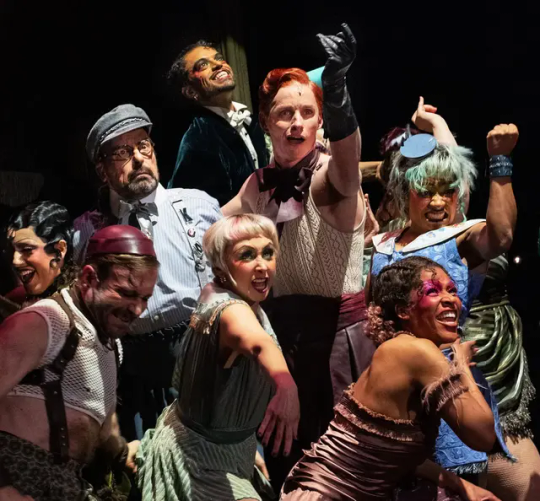
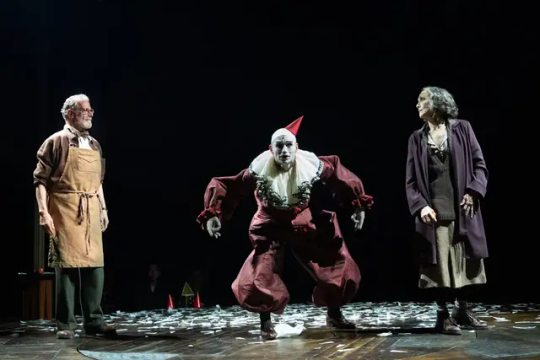

New Photos from NYTimes!
credit photos to Sara Krulwich/The New York Times
review here:
https://www.nytimes.com/2024/04/21/theater/cabaret-review-eddie-redmayne.html
Here you can find my post with the extended version review
https://www.tumblr.com/eddie-redmayne-italian-blog/748449610314448896/cabaret-review-what-good-is-screaming-alone-in?source=share
#eddie redmayne#gayle rankin#cabaret nyc#eddie redmayne cabaret#first review new york times#review cabaret new york times#broadway#musical theater#theatre#august wilson#te emcee#sally bowles#talented cast
19 notes
·
View notes
Text
I saw Here We Are, Sondheim's final musical, in its first preview last night. It was absolutely an incredible experience, and a memory I will cherish for the rest of my life. I wrote up a thorough review on my patreon, which you can check out below.
Even if you don't, I just want to say, it is the sort of show that Tumblr should love. It's everything we want, with our nonsensical vibes, and fantastic music, and meta jokes, and David Hyde Pierce. I can't wait for everybody to see and hear this incredible show.
#musical theatre#musical#musical theater#musicals#theater#theatre#sondheim#stephen sondheim#square one#here we are#the shed#broadway#nyc#new york#off broadway#review#theatre review#play#luis bunuel#surrealism#the exterminating angel#the discreet charm of the bourgeoisie
19 notes
·
View notes
Text
Kamasi Washington Electrifies Enthusiastic Beacon Theatre Crowd with New Album

Kamasi Washington – Beacon Theatre – May 4, 2024
“It’s good to be in New York,” exclaimed Kamasi Washington. One day after the release of his new record, Fearless Movement, the crossover jazz musician announced he’d be debuting most of the album’s material to the giddy Saturday night crowd at the Beacon Theatre. “We’re in this together,” he explained while leading his band through the first track, “Lesanu,” a tribute to a friend who had passed, but also, Washington described, a “celebration of gratitude.”




The song evolved from a wash of cymbals from drummer Tony Austin, then percussion, bass, keys and horn joining in. Washington is as much a bandleader as he is a player, a visionary as much as a saxophonist, but his solos, starting from the opening number, were tours de force, avalanches of melody dragging along the bass of Miles Mosley and the keys of Brandon Coleman, unstoppable momentum and power, somewhere amidst jazz, rock, soul and hip-hop.




Washington’s band has remained surprisingly consistent over the years and the comfort and the love he has for his guys was easy to feel. By the time they had completed the third song, 45 minutes had already transpired, and the rapt-but-rowdy audience had witnessed nearly every band member featured in an impressive solo. Ryan Porter on trombone and DJ Battlecat adding their thing to “Asha the First,” which went from larger-than-life to a quiet meditation, the band equally adept both ways.




“Computer Love” featured soulful vocals from Patrice Quinn and a building synthesizer solo from Coleman as well as soprano sax from Rickey Washington, Kamasi’s father. Mosley went full funk with a scintillating bass solo on “Road to Self,” which also gave Austin the spotlight on his relentless drumming. While the solos were all impressive and gave the new material an organic freedom, it was when the full band was working together, like on “Interstellar Peace (The Last Stance),” that the full weight of the ensemble turned the music completely weightless.




At points during the night, dancers appeared onstage, as if out of a dream, one of them appearing to float above the floor adding a surreal dreamlike depth to the music that was already plenty deep. The set closed after two hours with “Prologue,” the ending but a beginning as Washington explained, his band of close friends and family both heavy and light, powerful individually, even more so together. —A. Stein | @Neddyo



Photos courtesy of Ellen Qbertplaya | @Qbertplaya
#Aaron Stein#Beacon Theatre#Bowery Presents#Brandon Coleman#DJ Battlecat#Ellen Qbertplaya#Fearless Movement#Kamasi Washington#Live Music#Miles Mosley#Music#New York City#Patrice Quinn#Photos#Review#Rickey Washington#Ryan Porter#Tony Austin#Upper West Side
2 notes
·
View notes
Text
Back to the Future on Broadway

View On WordPress
#back to the future#back to the future musical#back to the future the musical#broadway#broadway musical#broadway musical review#broadway show#Broadway theater#broadway theatre#musical#musical review#musical theater#musical theatre#musicals#new york#New York city#winter garden theatre
2 notes
·
View notes
Text
Illinoise - St. James Theatre New York 09.05.2023
Illinoise - St. James Theatre New York 09.05.2023 #musical #dance #sufjanstevens #newyork #justinpeck #illinoise
Sicherlich trifft diese Show nicht jedermanns Geschmack und ist eher ungewöhnlich inmitten der grossen „Blockbuster“ am Broadway: „Illinoise“ – das Coming-of-Age – Dance Revue Musical mit der Musik des gleichnamigen Konzept-Albums von 2005 von SUFJAN STEVENS. „Illinoise“ ist grossartig und sehr bewegend…
Continue reading Illinoise – St. James Theatre New York 09.05.2023

View On WordPress
#Ben Cook#Coming of Age#Coming out#Illinoise#Jackie Sibblies Drury#Justin Peck#Kritik#Musical#New York#Review#Rezension#Ricky Ubeda#St. James Theatre#Sufjan Stevens#Vorstelungsbesprechung
0 notes
Text
From Doubt to Hope: How Cornelius Eady's Play ‘Running Man’ Reignited Broadway's Spirit at Lincoln Center
by Levi Wise Kenneth Catoe Jr.

April 8, 2024 - If you haven't already figured it out in the year 2024 post-pandemic, Broadway seems to be in a peculiar place right now. From a rhetorical point of view, every time a play enters Broadway, the same play soon exits. Leaving many to ponder whether Broadway will ever regain its footing. The discourse surrounding Broadway existed in a universe long before Hollywood, and its stars rivaled the social clout of all the Hollywood luminaries of the day. Stars such as Tallulah Bankhead, Mary Martin, Ethel Mermen, and the Barrymore family were more than Drew’s ancestors; these were A-List stars with the most pop mainstream appeal, but nowadays people are more likely to know who Drake is than who Ben Platt is, and this is not to create rivalry but only to ask what’s become of Broadway. Last night, Lincoln Center found the solution.

During Broadway’s current busy revival scene, which includes the occasional lackluster "Jukebox Musical' or what's become a relic these days, the 'Black Theater' that typically fails to find its audience among post-pandemic attendees, this is further proof of the axiom that some plays simply need to find their time to succeed. Several of the most famous theater works of today stand on the shoulders of artists whose names aren’t cited, remembered, or compensated. Many of these missing musical masterworks are often the labor of BIPOC creators and women. To remedy this state of affairs, the Cast Album Project—helmed by the multiple Tony Award-winning composer Jeanine Tesori (Fun Home; Caroline, or Change; Kimberly Akimbo) and Obie and Drama League-winning director Anne Kauffman (Marvin’s Room, The Sign in Sidney Brustein’s Window)—reconstructs the scores of lost musicals and records them in concert in the hopes of preserving them for future generations to rediscover.

One such reconstructed work is Running Man by composer Diedre Murray and poet Cornelius Eady. The disappearance of a young African American man is told through an explosive convergence of jazz, opera, and chamber music. This hauntingly beautiful story was a finalist for the Pulitzer Prize for Drama and won an OBIE for composition. Join us for a two-night-only concert of Running Man—finally capturing, for eventual release, a long-belated, first-time cast album. The libretto is based on Cornelius Eady’s cycle of poetry of the same name, published in the book Brutal Imagination by Penguin Random House, and was a finalist for the National Book Award. Ms. Murray and Mr. Eady have also collaborated on the musical theater pieces You Don't Miss Your Water, Brutal Imagination, and Fangs.

But, for me, it was that Lincoln Center setting that only added to the ambiance of the score. The Running Man cast was staged in front of the glassed wall of the venue; the lights were dimmed with lavender lights, with huge high ceilings and tall windows, as if the cast were performing in the late-night sky of NYC. As the audience viewed the masterful performances of the orchestra, singers, and conductors, the NYC evening traffic below Columbus Circle kept pace with the music as the chorus harmonized among the clouds and skyline. It was truly a spellbinding and amazing experience. It was impossible to look away because every single one of the actor's vocals suited the musical arrangement perfectly, and even when a mistake was made, it was so effortless that had the performer not indicated that they wanted to do it over, the audience would have never caught the mistake that was made. Once the show was over, I was ready to see more, but unfortunately, that never happened. The performance lasted around 90 minutes, and after the actors took a few bows, they were whisked away with no encores. Maybe that’s the metaphor for the evening Broadway, which was once here to stay, now only gets whisked away too quickly, but I will always be grateful for last night.

Levi Wise Kenneth Catoe Jr.
Editor, BOSS, NY
*excerpts from this article were taken from DO NYC
(Cast Album Project: Running Man, Day 2 at Lincoln Center)
#black theatre#black theme#black literature#black history#broadway#musicals#musical theater#musical theatre#theatre#black entrepreneurship#theater kid#black tumblr#poetry month#black fashion#news updates#album review#theater review#nyc#nyclife#new york#trending
1 note
·
View note
Text
Edinburgh International Festival Review: Day 18
The day started at the Amplify Festival event by the Marketing Society at Assembly where the main speaker was Frank Cottrell Boyce. He of children’s book writing, the 2012 Olympics opening ceremony and The Queen x Paddington fame. He gave a talk about humour and its values that was interesting, seemingly pretty spontaneous, totally self effacing and utterly charming. His best line, being a…

View On WordPress
#Alvin Ailey#Alvin Ailey American Dance Theater of New York review#Edinburgh#edinburgh fringe#edinburgh international festival#Festival Theatre Edinburgh#music#Revelations review#theatre
0 notes
Text
2D NEWSIES: What I would change
I just realised I've been making fake concept art for a nonexistent animated Newsies adaptation for four years now. Over time, I've been getting so many ideas for this adaptation if it ever became real, I thought I would share them with you guys! This includes story changes, cut and additional songs and ideas for characters and style. I would love to know your thoughts on these!
When I started making concept art for "2dsies" as I came to be called, I intended for it to be based on the Broadway version and the Broadway version only. However, stories on stage differ a lot from stories told on screen, it just doesn't work the same way. I do still prefer the storyline of Broadway Newsies, but I think the best version would be a combination of the best parts of all different versions, plus some necessary changes. I would want Newsies to be a love letter to every production we've had, to everyone who made happen and every theatre kid who's been geeking out over it since 1992, while also being its own standalone movie that can be enjoyed by anybody. I am in no way an adequate screenwriter, these are just a few suggestions I have for a better story!
Story
Like I said, the story will be based mainly on the Broadway storyline, meaning we still have Artist Jack, Katherine, and most elements from the show that aren't in the movie. It will, however, be quite different from the show and the movie, and maybe add some more of the real events from the newsboy strike. There are still some details and scenes I would like to add and some I would remove completely.
- I like the history lesson opening from the movie, it gives people just enough background information on the real historical events the story is based on. I don't know if it should be Racetrack or Jack narrating, though.
- In Santa Fe (prologue), Crutchie mentions he's afraid the other boys will find out about his bad leg, even though they all literally know him as Crutchie, and it seems to be the first time Jack tells him about his dream of going to Santa Fe, even though they've clearly been best friends for a long time. It feels off, UNLESS they only just met, which is why I love @raggedy-albert 's theory so much. I would have the scene start off with them as kids, and have them grow up throughout the song.
- I want to add a scene in the beginning of Katherine at the New York Sun to establish her character and motivations, and possibly a little foreshadowing. Just an idea for a scene; she goes to the editor to let him read her story covering the trolley strike, but he reminds her of "her place" and that she's lucky enough to be in the position she's in and that she should go review a vaudeville or something. This would not only give her a similar motivation to the newsies, but also, if we're gonna bring the women's rights movement into the story let's do it right!
- Of course I'd also like to add more romantic interactions between Jack and Katherine, to make their relationship more believable. However, I don't think they should be a couple immediately after the finale, I was more thinking of an open ending to their relationship where Jack takes his first step to staying in New York by finally asking her out.
- Maybe add the actual scene where Jack and Davey visit Brooklyn instead of having them tell the other newsies what Spot said right before Seize the Day. Show don't tell, you know?
- A scene where Jack visits Crutchie at the refuge, similar to the one in the movie, but with the sadness Jack describes it with in the show. Again, show, don't tell. Show me how Jack visits the place of his nightmares again only to find his best friend in a worse state than ever and being unable to save him.
- Katherine punches Jack after the rally. Give it to me.
- Additional scene after Jack and Katherine's song after the rally where Jack formally apologizes to the newsies. Because in the show it just cuts from "omg he's a sellout *spits on the floor*" to "yay captain Jack is back" and it just doesn't sit right with me.
Songs
- There should be an entirely new Pulitzer song. The Bottom Line is good but by far the most skippable song on the cast recording, and The News Is Getting Better (the off broadway cut song) is a little Better but not quite the evil capitalist song we need.
- Swap Something to Believe In for When I See You Again. It's such a sweet song and I think it suits Jack and Katherine a lot better. It's much more "Neither of us know what tomorrow brings but when I'm with you I know we can change things for the better, even if it's scary but for now let's be here together and forget the world for a bit" instead of "I love you but I'm still gonna chase my cowboy dreams"
- Cut Letter From The Refuge, since my idea was to have this be a scene instead.
- Some lyric changes!
In Santa Fe: "Crutchie's callin' me, he's fine, just too damn slow"
In Once And For All: add this lyric from the movie, "Better to die than to crawl".
In Seize the Day: "Friends of the friendless seize the day, raise up the torch and light the way", not in the song but in the reprise where all the working children of the city gather before the finale.
Additional: "Still it seems like the dream of a boy, not a man", from The Truth About The Moon, a cut song from the movie that was supposed to be sung by Sarah. I don't know where I would put this lyric, but it could be said or sung by Jack as he realises what he's really looking for is not actually Santa Fe.
Characters:
- I want to add more girls to the background newsies, first of all.
- Sarah still won't do anything for the plot, but Davey and Les could mention that they have a sister. She's still canon to me.
- Speaking of Les, let's make him more likeable and also more helpful.
- Snyder has two scary dogs with him at all times.
- Just and idea, maybe Denton could still be a character if we replace Darcy with him, or maybe combine the two. Have him be Katherine's chaperone and friend formally, but also her reporter bestie. They could be a fun journalist duo!
Style
- The movie will still include the iconic choreography, which means it couldn't be fully 2D, but rather a mix between hand drawn and CGI.
-I would love for the backgrounds in the movie to be similar to impressionist and romantic art styles from the 19th century, to really sell how it's a story told from Jack's perspective. Especially his dream-like imaginations of Santa Fe would be brilliant in this style.
- I want to include a lot of weather foreshadowing. Rain right before Seize The Day and the sun breaking through when Davey starts singing. Mist surrounding Snyder and sudden darkness whenever he's near. A beautiful sunset when Jack and Katherine are alone on the rooftop. And of course, partly cloudy, clear by evening. It's such a cool way of visual storytelling when you have a plot that has no magic involved, like in most Disney movies.
- The real people characters' designs (Pulitzer, Hearst, Roosevelt) can be based on political cartoon caricature versions of themselves.
And lastly, quotes from the movie I liked that could be inspiring for the animated movie:
-"When I created the World..." "🙄" and "Where was I?" "You created the World, chief?"
- "No, we'll be just a bunch of angry kids with no money"
-"What, you couldn't stay away?" "Well I guess I can't be something I ain't." "A scab?" "No, smart."
Many of these ideas are still in development. Some might work, some may not, but I will be basing any future work I'll post on here on these ideas. I would love to see you guys discuss and add on to these!
152 notes
·
View notes
Text
Theatre Review: The Seagull/Woodstock, NY (Pershing Square Signature Center, Off-Broadway) ★★★★
Playwright Thomas Bradshaw retains the spirit of one of Chekhov’s most celebrated works while bringing it sharply into present day America with his adaptation, The Seagull/Woodstock, NY, currently receiving its world premiere Off-Broadway produced by The New Group at Pershing Square Signature Center.
As the title suggests, the action has been transposed from rural Russia to Woodstock in the…

View On WordPress
#anton chekhov#gay#gay character#gay theatre#hari nef off-broadway#hari nef the seagull review#hari nef theater#HIV/AIDS#HIV/AIDS theatre#James Kleinmann#lgbt#lgbtq#lgbtq theatre#new york theater review#New York theatre#off-broadway review#off-brodway#Parker Posey#parker posey in The Seagull/Woddstock NY#queer#queer theatre#the new group the seagull woodtock ny review#The Queer Review#the queer review the seagull woodstock ny#the seagull off-broadway review#the seagull review#the seagull woddstock ny the queer view#the seagull woodstock ny review#theater#Theatre
3 notes
·
View notes
Text
‘Cabaret’ Review: What Good Is Screaming Alone in Your Room?
Eddie Redmayne and Gayle Rankin star in a buzzy Broadway revival that rips the skin off the 1966 musical.
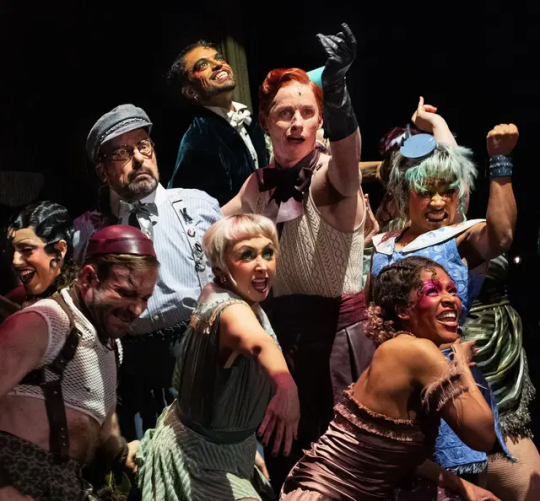
Eddie Redmayne, center, as the Emcee in Rebecca Frecknall’s revival of “Cabaret” at the August Wilson Theater in Manhattan.Credit...Sara Krulwich/The New York Time
By Jesse Green April 21, 2024
Just east of its marquee, the August Wilson Theater abuts an alley you probably didn’t notice when last you were there, perhaps to see “Funny Girl,” its previous tenant. Why would you? Where the trash goes is not usually part of the Broadway experience.
But it is for the latest revival of “Cabaret,” which opened at the Wilson on Sunday. Audience members are herded into that alley, past the garbage, down some halls, up some stairs and through a fringed curtain to a dimly lit lounge. (There’s a separate entrance for those with mobility issues.) Along the way, greeters offer free shots of cherry schnapps that taste, I’m reliably told, like cough syrup cut with paint thinner.
Too often I thought the same of the show itself.
But the show comes later. First, starting 75 minutes beforehand, you can experience the ambience of the various bars that constitute the so-called Kit Kat Club, branded in honor of the fictional Berlin cabaret where much of the musical takes place. Also meant to get you in the mood for a story set mostly in 1930, on the edge of economic and spiritual disaster, are some moody George Grosz-like paintings commissioned from Jonathan Lyndon Chase. (One is called “Dancing, Holiday Before Doom.”) The $9 thimbleful of potato chips is presumably a nod to the period’s hyperinflation.
This all seemed like throat clearing to me, as did the complete reconfiguration of the auditorium itself, which is now arranged like a large supper club or a small stadium. (The scenic, costume and theater design are the jaw-dropping work of Tom Scutt.) The only relevant purpose I can see for this conceptual doodling, however well carried out, is to give the fifth Broadway incarnation of the 1966 show a distinctive profile. It certainly does that.
The problem for me is that “Cabaret” has a distinctive profile already. The extreme one offered here frequently defaces it.
Let me quickly add that Rebecca Frecknall’s production, first seen in London, has many fine and entertaining moments. Some feature its West End star Eddie Redmayne, as the macabre emcee of the Kit Kat Club (and quite likely your nightmares). Some come from its new New York cast, including Gayle Rankin (as the decadent would-be chanteuse Sally Bowles) and Bebe Neuwirth and Steven Skybell (dignified and wrenching as an older couple). Others arise from Frecknall’s staging itself, which is spectacular when in additive mode, illuminating the classic score by John Kander and Fred Ebb, and the amazingly sturdy book by Joe Masteroff.
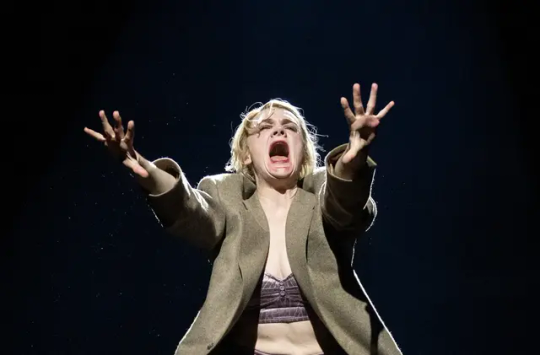
In this production, Gayle Rankin’s Sally Bowles is meant to be taken medicinally and poisonously, projecting instead of concealing her character’s turmoil, our critic writes.Credit...Sara Krulwich/The New York Times
But too often a misguided attempt to resuscitate the show breaks its ribs.
The conception of Sally is especially alarming. As written — and as introduced in the play and stories the musical is based on — she is a creature of blithe insouciance if not talent, an English good-time gal flitting from brute to brute in Berlin while hoping to become a star. Her first number, “Don’t Tell Mama,” is a lively Charleston with winking lyrics (“You can tell my brother, that ain’t grim/Cause if he squeals on me I’ll squeal on him”) that make the Kit Kat Club audience, and the Broadway one too, complicit in her naughtiness.
Instead, Frecknall gives us a Sally made up to look like she’s recently been assaulted or released from an asylum, who dances like a wounded bird, stretches each syllable to the breaking point and shrieks the song instead of singing it. (Goodbye, Charleston; hello, dirge.) If Rankin doesn’t sound good in the number, nor later in “Mein Herr,” interpolated from the 1972 film, she’s not trying to. Like the cough syrup-paint thinner concoction, she’s meant to be taken medicinally and poisonously in this production, projecting instead of concealing Sally’s turmoil.
That’s inside-out. The point of Sally, and of “Cabaret” more generally, is to dramatize the danger of disengagement from reality, not to fetishize it.
The guts-first problem also distorts Redmayne’s Emcee, but at least that character was always intended as allegorical. He is the host to anything, the amoral shape-shifter, becoming whatever he must to get by. Here, he begins as a kind of marionette in a leather skirt and tiny party hat, hiccupping his way through “Willkommen.” Later he effectively incarnates himself as a creepy clown, an undead skeleton, Sally’s twin and a glossy Nazi.
Having seen Frecknall’s riveting production of “Sanctuary City,” a play about undocumented immigrants by Martyna Majok, I’m not surprised that her “Cabaret” finds a surer footing in the “book” scenes. These are the ones that take place in the real Berlin, not the metaphorical one of the Kit Kat Club. She is extraordinarily good when she starts with the naturalistic surface of behavior, letting the mise en scène and the lighting (excellent, by Isabella Byrd) suggest the rest.
And naturalism is what you find at the boardinghouse run by Fräulein Schneider (Neuwirth), a woman who has learned to keep her nose down to keep safe. Her tenants include a Jewish fruiterer, Herr Schultz (Skybell); a prostitute, Fräulein Kost (Natascia Diaz); and Clifford Bradshaw (Ato Blankson-Wood), an American writer come to Berlin in search of inspiration. Soon Sally shows up to provide it, having talked her way into Cliff’s life and bed despite being little more than a stranger. Also, despite Cliff’s romantic ambivalence; over the years, the character has had his sexuality revamped more times than a clownfish.
The Schneider-Shultz romance is sweet and sad; neither character is called upon to shriek. And Rankin excels in Sally’s scenes with Cliff, her wry, frank and hopeful personality back in place. The songs that emerge from the boardinghouse dramas are not ransacked as psychiatric case studies but are rather given room to let comment proceed naturally from real entertainment. Rankin’s “Maybe This Time,” with no slathered-on histrionics, is riveting. It turns out she can properly sing.

The interface between the naturalism and the expressionism does make for some weird moments: Herr Schultz, courtly in a topcoat, must hug Sally goodbye in her bra. But letting the styles mix also brings out the production’s most haunting imagery. The intrusion of the Nazi threat into the story is especially well handled: first a gorgeously sung and thus chilling version of “Tomorrow Belongs to Me,” then the swastika and then — well, I don’t want to give away how Frecknall stages the scene in which Schultz’s fruit shop is vandalized.
That so many of these moments arise from faithful attention to the original material should be no surprise. “Cabaret” hasn’t lasted this long for nothing. Created at the tail end of Broadway’s Golden Age, it benefited from the tradition of meticulous craftsmanship that preceded it while anticipating the era of conceptual stagings that followed.
All this is baked into the book, and especially the score, which I trust I admire not merely because I worked on a Kander and Ebb show 40 years ago. That the lyrics rhyme perfectly is a given with Ebb; more important, they are always the right words to rhyme. (Listen, in the title song, for the widely spaced triplet of “room,” “broom” and, uh-oh, “tomb.”) And Kander’s music, remixing period jazz, Kurt Weill and Broadway exuberance, never oversteps the milieu or outpaces the characters even as it pushes them toward their full and sometimes manic expression.
When this new “Cabaret” follows that template, it achieves more than the buzz of chic architecture and louche dancing. (The choreography is by Julia Cheng.) Seducing us and then repelling us — in that order — it dramatizes why we flock to such things in the first place, whether at the Kit Kat Club or the August Wilson Theater. We hope, at our risk, to forget that, outside, “life is disappointing,” as the Emcee tells us. We want to unsee the trash.
Cabaret
At the August Wilson Theater, Manhattan; kitkat.club. Running time: 2 hours 45 minutes, with an optional preshow.
Jesse Green is the chief theater critic for The Times. He writes reviews of Broadway, Off Broadway, Off Off Broadway, regional and sometimes international productions. More about Jesse Green
https://www.nytimes.com/2024/04/21/theater/cabaret-review-eddie-redmayne.html
#eddie redmayne#cabaret#cabaret nyc#review new york times#broadway#eddie redmayne cabaret#cabaret nwe production#august wilson#theatre#cabaret 2024#musical#cabaret musical
10 notes
·
View notes
Text
WAD reflection from the perspective of a theatre director
Inspired by @/calvinahobbes who did an amazing job breaking down the show’s metaphors & using her English degree in this post, I wanted to share my perspective on it (even a month later) & get use out of my theatre degree lol. Also, warning, this will be very much a long, long essay with run-ons. I have ADHD & I love when my frequent hyperfixations intersect 🤪 There are major spoilers.
My Background:

I am a semi-professional theatre director, but more broadly, a theatremaker. I have a theatre degree from New York University’s Tisch School on the Arts (NYU Tisch), where I did a conservatory program with one of their studios which focused basically on those who wanted to do a little bit of everything and create new works & was the only studio training directors & playwrights. I originally went into the program as a performer. I did not mean to end up concentrating on being mainly a producer & a director, but that’s a whole other story. I also through that program had to take theatre/performance studies courses, which I loved for the most part & is an interesting interdisciplinary field. But I will try to define terms just in case since anybody reading this may not know any or all the specific terminology I might use. In short, I have a fancy degree that apparently should cost $300k 🤡 & I’m gonna actually use it with doing this lol
--
Setting the Tone:
While Dan might call this a comedy special or comedy show, and thereby comparing it to other comedians, I actually think he is doing himself and We’re All Doomed (WAD) a disservice. I saw folks compare him a lot to Bo Burnham in the chat (who was actually was accepted and almost went to NYU Tisch for a different studio that focused on solely experimental work), which makes sense considering the theatrical nature of both of them. However, Dan actually goes further into the realm of theatre because of how he utilizes his crowd work (I’ll go into that later). I recognize traditional comedy specials/standup as having jokes or stories, when doing you know like late night talk show interviews, that can be made outside of the context of the show & slip into a conversation. Or with Burnham’s Inside Out, the songs & other parts can be done or understood mainly out of context, as seen through Bo uploading them to his YouTube channel. Comedy specials have the sections of their comedy stand-up thread together, but what Dan has done is weave his sections together. The length along with the intermission/interval being a part of WAD, adds to my point that he is not treating this as different material he tested out at different comedy clubs, but as something cohesive storytelling pieces. I think in terms of testing, Phil was the main sufferer audience member of the initial materials being created.
Anyway, you cannot as easily remove it from the context at certain points, because the transitions & the order of these different sections are treated as equally important, rather than a means to move on to the next section, with some possible space for improv.
Basically, I’m bi. Sorry, my brain started thinking about BIG when I started writing “basically” at the start of that sentence. Actually, what I am trying to say is that I would classify We’re All Doomed as a one-man performance piece/show, so I will be treating it as such in my review/reflection/breakdown. The comedy of it is important and there, but I don’t think it captures what WAD entirely is.
Also, unfortunately due to where I was at mentally at the time & the location it was being performed at, I never saw this live. To be honest, how it got framed marketing-wise did not help me feel connected with the actual purpose of the show, with hope being a key element. So while this was filmed, I am as much as possible trying to remove the cinematography as an element of my analysis. However, some things might be clearer on film, as with theatrical directing, you cannot add a zoom or crop & instead are trying to ensure moments are clear to an audience by what they see and hear through drawing their attention to it. With theatre being mainly about the live output by performers and intake by the audience, at the end of the day, what my job as a director is is to direct not only how the performers share the story, but also direct the audience on what is important to catch for understanding.
--
Breakdown of Thoughts
Originally, I wanted to rewatch the show again, and started to, but considering I ended up writing about a whole page worth of things for each minute of the show & I was sleepy by the time I was like 5-10 minutes in, I decided to be nice to myself & stay up all night in my comfortable bed instead of staying up all night at my desk trying to take in-depth notes 🙃
I’m gonna breakdown this analysis/reflection into further sections, just to give myself some anchors & break up the blocks of text. Also as a way to just be that pretentious, maybe with an academic flair, as is fitting to be for something about Dan Howell (said affectionately 💕)
The Script/Writing
When considering the text of the show itself, two things came to mind for me:
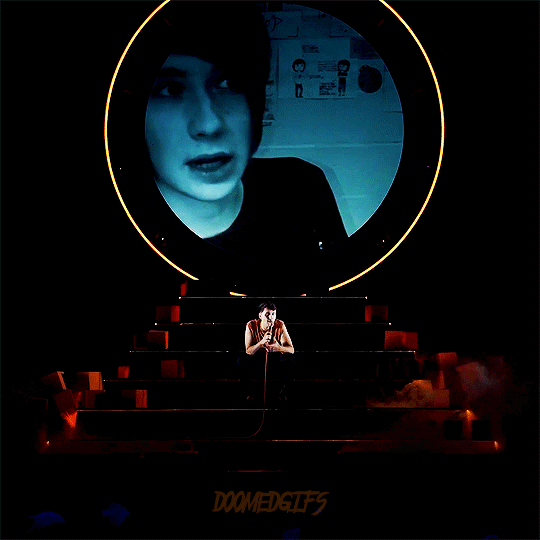
(1) This is definitely what I would call intertext. Intertext is a piece of writing that relates to another or more other writings through allusions. WAD is an intertext which alludes mainly to other works of Dan’s on his YouTube channel. The ability to get the true impact of the show relies on you knowing Dan (as his internet persona) on some level. And as a theatre maker & longtime fan, I love that it is, it’s what the piece needed to be. As a theatre producer, the hiatus from engaging with his audience and the limited runway given to reactivate interest in him and his creative work I think made it difficult to get that audience in some venues, along with some other funkiness (mainly with promo) I am less knowledgeable on. But I think Dan has already learned/continues to learn from that, which I think may have been valuable for him. (sidenote: I need the tea on all that because I love knowing how presenting venues work with performers, as well as the lack of understanding they have of internet culture as it relates to venue leadership.)
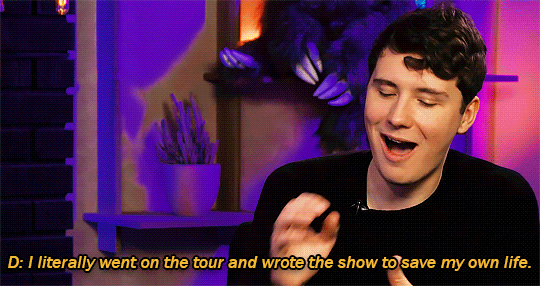
(2) This was a work he made for himself. He mentions this both in the show & in reference to WAD multiple times. But I think what truly came to mind for me was that it is still powerful for him to write for himself. He is writing for what he needs to be hearing or wants to be processing creatively.

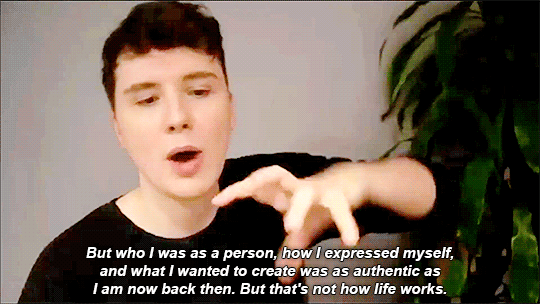
I think why it is powerful is that Dan has discussed before how much stress he put on himself regarding danisnotonfire, and later Daniel Howell, videos, focusing on the audience, and how he was presenting a specific style/quality of video to them. Add in the layer of being closeted & actively fighting internalized homophobia, and the anxiety he built up makes sense. And I might personally attribute that more to his need to pass as straight & catering I believe at one point to an audience of cishet men, whether actual or perceived by him. Not all videos, especially the most impactful ones in my opinion, rely on this, but it was a key piece of what he made during his rise in popularity on the platform. This catering slowly decreased with the amount of uploads he was doing, along with a more tangible understanding of his audience thanks to the tours he did with Phil. Basically I’m Gay I think was the true shift where he gave himself permission to write work that had a main audience of himself. That’s where his best work has come from, and I think since then, he’s been able to have the space to process things creatively through his writing.
--
The Relationship Between Performer & Audience
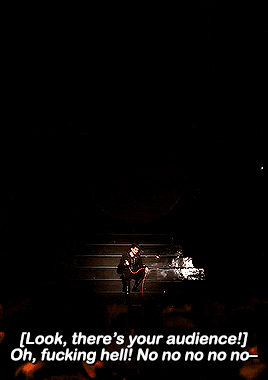
When I was in theatre school, my directing teacher would constantly talk about not just considering the relationship of the performers on “stage” (I did a lot of more immersive work & we only had black box theatres, which is literally a room that is floor to ceiling black) but also the relationship of the performers & the story with the audience. By Dan knowing mainly who his audience would be, the show can now play with that understanding in mind.
This leads to my point that, overall, Dan does not use the fourth wall, and I think that is what makes We’re All Doomed work. It may also be why he called it a comedy show, idk.

For those who don’t know what the fourth wall is, it is a term from theatre originally that is about the way in which a traditional theatre stage (called a proscenium) has three physical walls around it, while there is no 4th physical wall, so the audience can see the performance. If does exist physically, it is only the curtain that acts as the 4th “wall”. So, in order to keep it as a separation between the performers and the audience, the actors treat the side where the audience is as a fourth wall. When someone breaks the 4th wall, this is when they speak to audience directly, rather than to another character. Examples from English-speaking pop culture would be the asides from Hamlet or Ferris Bueller in Ferris Bueller’s Day Off. But when you are the only person on stage, the only way to have a fourth wall is when you don’t reference that you know there’s an audience there. Hence, a monologue where the character is talking to themselves or an entity that is not the audience directly (or assigned to be the audience by the director), it is the closest you can have a fourth wall when alone.
Dan in his videos and in his previous tours with Phil never were without direct engagement of the audience (obvious with the naming of Interactive Introverts). It was never not a variation on him speaking with the audience in any type of dialogue, even if done parasocially.
Some of that is not new to theatre, but I would say is that it has become more of a trend within new theatre starting in the early 2010s to have more interactivity and a more authentic, explicit message that no performance will be the exact same. I definitely saw that in the shows I saw both Off-Broadway (which sidenote, all that means is that there’s fewer seats in that theatre, not about quality of the work or how worth it is to engage with) and larger settings like Broadway and the West End. That’s what I love about theatre, and why my own work is more about immersion and direct audience engagement.
Now Dan’s creative works have never been skit only or interested in telling a story outside of the realm of connecting with an audience as a variation of himself, so again, him not using the fourth wall overall is appropriate and fits in with what I mentioned about intertext. The piece does however start with a fourth wall for the music number, which I will walk through fully sharing why I am saying that about the song & dance opening after establishing some other concepts to help build understanding.
--
Design Can Work With You or Against You

I just want to say out the gate that the design was done really well, and I immediately felt a need to emphasize it after watching the first 10 minutes again.
First, let’s talk about the orange & black aesthetic of the show. Dan may have simply said that the orange just looked cool, but I think I would attribute more meaning to that color. Orange brings to my mind at first instance both a bright happiness/warmth and a sense of caution and warning, like road signs (at least those in America). The themes of the show reflect these two ideas and plays with the tension between them. I don’t know if he or the team meant to have that be a conscious choice, but there’s a joke I’ve had with other directors of when they get complimented on something unexpected, they just nod and say “yes, that was a choice”, even though it was just a random thing that happened or was something that you just thought would be cool to do. Orange runs through the show’s designs and it becomes clear that it is a tool for contrast and emphasis for the points Dan & the director want to make.
Now with the design team of costumes, lights, sound, and media, I can see a clear cohesion. Good theatrical design has the designs act as a character or highlighter in the story. Bad theatrical design can take away/distract from the core intensions of the show. It was so clear to me that the design was a character. And seeing that there were two media designers make complete sense considering the labor lift of both creating the projections displayed, but also creating/filming pieces of the media itself. The music/sound and lighting work well to articulate the manic feelings it means to instill in the audience and seeing it as a director, I assume part of the creative discussion was about parts of the media played they wanted to make sure were heard, and the lights help catch attentions in service of those pulled out moments. For costumes, I think Calvina did well in her post at articulating the elements of the costume and the progression it goes throughout the show. I’d rather not take up space to say the same thing truthfully.
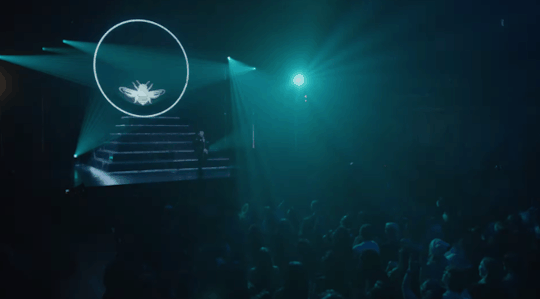
With all the design elements, I think three characters could be defined (not including the audience), two as main characters, and one as a supporting character. I would name the main characters as “the Circle” (the looming set piece throughout hosting the projections used throughout) and “Dan On Stage/Dan performing” (the one in the physical space) with the “voiceover Dan/inner voice Dan” as a supporting character. The voiceover only exists in the beginning, and it is only shared with us to demonstrate the way in which the Dan On Stage singing is not really that aggressively optimistic and wholeheartedly believes the words he is singing. He is not the Dan we know from the Internet, so we can cathartically laugh at the attempt to pretend everything is fine. The voiceover only has one role, and it is to force Dan to confront this breakdown has an audience.
--
Staging an Opening Sequence: Our First Stage Character is the Circle

In directing classes, often what you focus on is called stage pictures, which is meant to help you consider what the actual imagery you want to ensure the audience absorbs for their understanding of the piece. The first and last stage moment of each act should tell a basic story of what happened, and therefore, are heavily emphasized as important for directors. The Circle (capitalized for reference purposes) being lit up before the show starts and then again in conjunction with the light flashes and sound establishes the importance of the Circle to the show. When the projection comes into play, showing the speech of a 15-year-old Greta Thunberg before beginning to add more, we are then introduced to the purpose of the Circle to be an output/portal for the overstimulation of messages, in this case, I would claim it being what comes from the Internet.
The music/sound and lighting work well to articulate the manic feelings it means to instill in the audience and seeing it as a director, I assume part of the creative discussion was about parts of the media played they wanted to make sure were heard, and the lights help catch attentions in service of those pulled out moments. The Circle also through some of the lighting moments, mimic that of a clock, which again adds to the doomsday, the "end is near" type energy. To have the end of the opening sequence build to an explosion which then shows solid orange at the end while Dan is in silhouette begins the introduction to the orange emphasis & proposes a sort of prophet-like version of him after the apocalyptic imagery disappears as he rises to be seen. What we have opened with is setting the tone to how we should view these two characters of the Circle & the Dan on Stage.
--
Song Time!

Dan is such a theatre kid & I love that for him. His dramatic side shows through the moment he used a rise to start his show at the top of the stairs, first in a place of seriousness with the sharp lighting and smoke to then bring in a very happy music number. The contrast & switching of expectations is a key of comedic works, and shows through most of the phandom who did not know WAD started with that, as it is indeed funnier if it comes as a shock. The movement & music mimic what folks attribute to as musical theatre, which is campy, happy singing. Knowing he was the one who suggested the song for TATINOF, I am loving Dan clearly wanting to have that opening number of a musical moment, even if it is dripping in irony. The Circle & the lights in this acts as a supporter to the message of it being sunshine and rainbows, with literal rainbow lights included. (Sidenote: I am 99% sure the pigeon coo is Phil, so if anything, I’m disappointed he was not credited as Pigeon sound effect AND remote crisis manager. Idk why I could tell, but both times now, it’s what I immediately thought when hearing that part)
I think of the musical number as the only place where he does have a fourth wall, because the number does not directly reference the audience at the start. It’s a one-man moment and it is about the performance not the audience engagement. It starts falling away when he starts pointing out the “and you”s, but the voiceover is the real break in our understanding of the world. It is emphasized by the color inversion of the sun & sky media of the Circle. The director is saying, this is important to how you now interpret what you’ve seen & will see, this is another shift from what was established of this world.
I should mention “world” is the terminology used to name what the environment the story is being told in with consideration, especially in theatre, of how much of a need there is for suspension of disbelief. I believe this term is also referenced a lot when discussing the fantasy and sci-fi genres, since those also requires some distancing from reality for the audience. This ties into a phrase I will probably end up using a lot of “rules of the space”. When establishing this world for the show you are presenting to an audience, there is a type of logic that must be established in order to understand what is the baseline for what the audience will be engaging with over the span of the show. But the voiceover immediately changes the rules of the space, because it messes with the Dan on stage, and messes with the messaging of the Circle. It adds a new context to the Dan On Stage, as while a fan will know that this song is not in alignment of our knowledge of Dan Howell, we get confirmation that this indeed ironic and outside of the branding that Dan has boxed himself into over his time on YouTube.
But the voiceover is also not in alignment with that “branding”. It expresses concerns related to the Dan On Stage’s mental wellbeing. There is no irony or subtext in that voice, it is the most direct in speaking to Dan On Stage, because it is being said by a variation of Dan in voiceover to himself. These could be seen as questions he knows to ask himself, but as someone who advocates for mental health & shares now about being openly gay, I interpret that he may feel he cannot express that outside of his mind for fear of undermining his advocacy points. The discussion of the “wonders” of the Internet also continue building in the tension that exists throughout WAD of how Dan feels about that space. The voiceover then proposes at first a type of equal extreme, which only sees the Doom, and as someone with clinical Depression myself, I think is only a furtherance of the breakdown, rather than the reality check it started off being. Not that what is listed is wrong by any means, but the barrage of it is meant to expand the drowning feeling, not act as call to action or consideration of the intricacies for engaging in the world. With the Circle’s sun imagery & the music having been inverted and shifted to something more sinister, Dan’s movement up the stairs fits a type of circular moment from the first entry of him, where the image of the prophetic figure is questioned on how he alone will solve the climate emergency. The slap & break of character for the Dan on Stage serves to confirm our understanding of the voiceover as the voice in Dan’s head & indeed there are not two Dans.

Also, the sparklers 🎇 showing up really make the key change for the song, but my producer brain is going, “girl, of course you lost money on this show, was that so VERY NECESSARY?” But the dramatic Gemini theatre bitch in me would 100% want this too. I just don’t have a capita£ester working to get sponsorship money in my life, so I have to be reasonable 😔 Also, the confetti with the high note is peak theatre gay so I again, love that for him. And of course, the confetti is orange.
--
Hints of Orange

When the song reaches its end & the Circle starts showing squares of orange, rather than a full background, this acts as a seed for the breakdown and waterfall of cubes, which Calvina speaks to the orange cube hint at the beginning in her post. The sudden cut-out with Dan simply lit replicates a moment the Circle is not present. The Internet is not present. To crawl to a microphone, the message is not “hey this guy needs two mics”, because we see one on his face, but that the wired mic (which I will now label as “The Microphone”) is a metaphor. It’s a crawl towards sharing out, not suppression. Only when the voiceover of himself points out the audience does he does a full fourth wall break. The suppression did not work, and neither he nor the audience can believe that it was the Truth.
The wire of the Microphone being orange showcases that it was meant to be seen. I don’t think it even in play in terms of the sound, like it might not even be on, considering the feedback nightmare it would likely cause. And no standard microphone used on stages has orange wires, because that would pull the audience’s eyes to it. But that’s the point here.

The rules of the space are now this: the Circle is not always active, the Microphone has significance, the Dan On Stage knows there is an audience. None of these were true before, even the Circle was on before the start. This draws the audience to know there has been a shift & to have the first words said into the Microphone be “We’re All Doomed” solidifies the song moment was a blip, that this is really where we start at. As an example, in the social media section, Dan does a deliberate wrapping of the wire on his hand at the same time the Circle scrolls to the social media icon. It is how the director & Dan are ensuring that we understand “what he is saying and what is been shown on the screen are in tandem”, so if you’re paying attention to that wire, it signals you should look up too.
Every other prop, except I believe the gavel and wig, is also orange. The bubble gun is mainly what comes to mind for me, since the cubes are not as activated as props necessarily. But if an item is to enter the stage, what I interpret it as is that it must be orange, there must be high contrast, nothing in the physical world on the stage can become blurred, only screens have that privilege(?) to have things blend together.
--
The Power Struggle Between Dan & the Circle
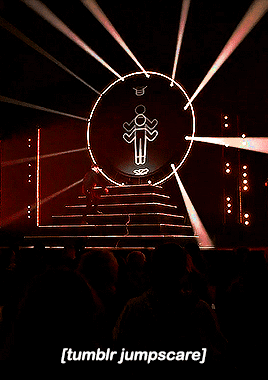
Once Dan has begun directly conversing with the audience, the rules of the space are:
(1) Dan On Stage acts, the design elements react (not including the Circle)
(2) The Circle and Dan have a symbiotic relationship, as neither have complete control over the other & react to what each other are doing
(3) The icons are our guides in understanding the sectioning done throughout the show
(4) Having “One Good Night” is the goal to reach at the end of the piece
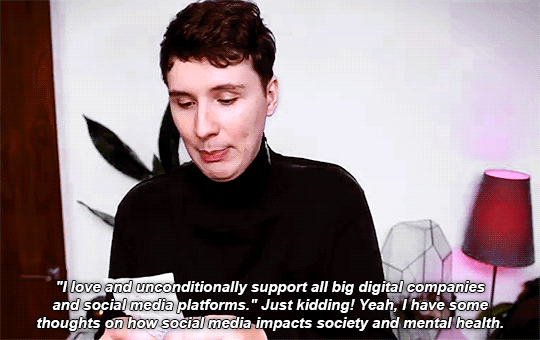
As a person, as well as discussed throughout the show, we know that Dan has a contentious relationship with the Internet. It is what has given him his living but has also caused some of his worst moments mentally (2012? I don’t know her). It is the space in which lets him have an audience who have mainly showed him support, but also the space that has fed the cynicism that fuels his clinical depression. There lies in the way in which the Circle exists on the stage & looms over Dan in the background. It’s a necessary evil of what appears on the screen.
Why do I then say that the design elements are reacting? Well, if we remove the Circle from the equation, the lights, sounds effects, and props are all cued off of something Dan does like the clown honk. However, the Circle sometimes cues off what Dan does, but sometimes instigates what Dan speaks to. That especially is evident when video clips play that invoke what media Dan has been contending with on the Internet and the consequences of those things.
The Circle exists throughout both Act One & Act Two, but only becomes passive to the piece when Dan directly shows vulnerability & the removal of protective irony. Calvina spoke to this when discussing the costume choice of him opening the jumpsuit in Act Two to show the orange tank underneath.
--
Cubes as Articulators
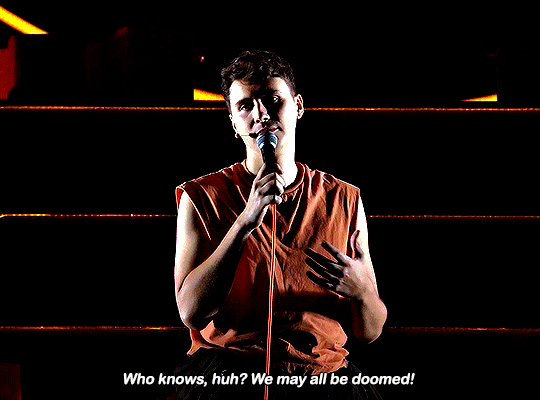
Oh Creator did I have to dig deep into my brain for this term of articulators. So my directing instructor had some key terms that I think I don’t think are universally used, even by American theatre directors or at least in academic settings. She defined articulators to basically be elements that helped give almost like checkpoints for the progression of a throughline in a show. For WAD, that is easily those orange cubes.
When static is displayed on the Circle’s screen each time we transition to a new section, it is not the typical emulation of TV static, it is that sea of orange squares. It is an articulation of those fear, issues, concerns, all those pinpoints Dan speaks to why he says “We’re All Doomed”.
That’s why there is the culmination of the orange cubes falling on him, when he reaches the top of the stairs at the end of Act One. When he circles back to the same stage picture of him at the top, it can been considered a repetition of the prophetic imagery I pointed out from the opening sequence. What changes is that the orange squares enter the physical world, falling onto Dan. He can no longer say they live in his head. They are here and stay in the space until the end of the show. In Act One, they are the looming issues that signal the Apocalypse. In Act Two, they are the rubble that must be sorted through.

Calvina was the one who named it rubble and the cubes as representations of Dan’s problems. To have the audience actually able to take a cube home, she argued, would be symbolic of the audience helping carry that weight. While I’d love that, I mentioned in my tags on her post that I think mentally, that rubble would still be at his feet, even with taking home that visual metaphor. This is Dan we’re talking about, and with personal responsibility being a topic of the show, while it’s not his burden to bear alone, he does have to recognize it exists.

I think the repetition of the prophetic imagery comes to its climax when in the aftermath found in Act 2, voting who to fire into space can and does end up with him being sent by the audience. It represents an understanding of where he exists now from where he did at 18 in terms of social, political, and economic access and the possibilities of his influence. There is a responsibility there that ties to how he can move in the world now publicly, so why wouldn’t he have an existential crisis?


--
It is a Comedy Though, Right?
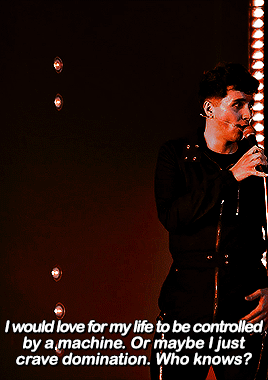
This is hundred percent comedy, and obvious dark humor at that. As a director, I love comedy, especially this type, because when an audience gets to laugh, the armor gets stripped away. They have no built-up resistance that let’s any uncomfortable point be heard effectively. It’s why the end’s vulnerability is effective, because we have already joked and laughed about our pains and our desire for escapism. Now we are able to move on into a place of reflection.
To underline why I say this is not stand-up comedy is that Dan has made it a stage show, just one that has comedy as a vehicle for telling this “story”. His interactions with his audience, through both quips based on audience reactions or “heckling” as well as explicitly asking for input into who to shot to space or what to add as a mad lib (generic brand for law purposes), are about being blended into the loose narrative constructed already, not actually to be reactionary like most crowd work I associate with stand-up comedy.
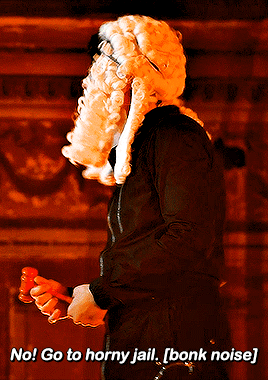
If anything, I could argue that it could be considered a comedy special that “Dan On Stage” is trying to make, but there is actually conflict being introduced that disrupts his set (both the comedy one and the physical one). There is clearly a showing of meta, as Dan makes sure to share thoughts on the creation of the show, the reactions from his overall show branding & imagery, the use of the lift because it was expensive to have. Dan’s comedy style can never be told without reference to behind the scenes, because if this is a creative means to process feelings, there are things about the show & its making that impact what needs to be processed too. It is also related to how his work is strengthened by acknowledging the two-way street of being in a parasocial relationship with his audience.
--
Can We Have One Good Night?

Another term central to what my directing teacher spoke of was the “Core”, usually a question, though not always, that motivated what was being explored over the course of a theatre piece. At the top, as Dan on Stage exaggerates that love doesn’t exist (which Dan refutes as being an actual belief of his during the afterparty) and other sardonic phrases, he also states he wants to give his audience one good night, because he recognizes the escapism his audience finds in his solo and joint content. We’re All Doomed’s Core is “can we just have one good night, even in the midst of the horrors we have outside of these theatre doors?”. But I would also say that in terms of where his writing was at the time of WAD’s inception and the naming of his mental health book as You Will Get Through This Night, it feels more like Dan himself has been grappling with a Core of “can I have one good night? Or a full 24 hours where I feel mainly happy when all I am bombarded with about the world is suffering?” I think night can be both literal, since we know he has had sleep issues, and metaphorical, as the night can represent this depressive episode he was writing himself out of.
When the mood tracker gets discussed in the last portion of WAD, to see a sea of neutral or uninterested emojis demonstrates when he took the time to do it, the answer that night was “no, not really” 😕. The main one mentioned is the ritual of “Fry Day” he has with Phil (sidenote: why are these British men not calling it “Chip Day”, since this ritual falls on a Saturday?), which is a rare smiley face. The question he likely has then is “can I ever have a good night again?”
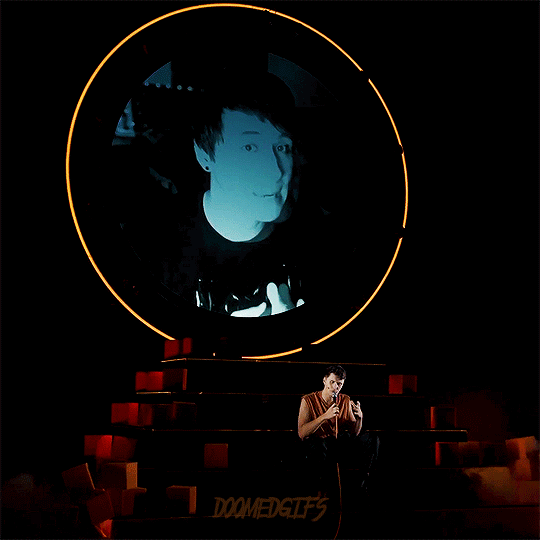
So for him to then turn to his own videos during one of those nights, to a video where he states his famous “embrace the void and have the courage to exist,” that showcases what I mentioned of his best work being written for himself, in this case, a future version of himself.
--
Ending Sequence: Where Do We Land?

When the Circle does not display any media, it again shows the orange square motif, but after mentioning his own video, he turns to his audience for glimpses of what joy exists even in the face of Doom. The Circle changes into a display of different submitted clips showcasing this joy and hope that Dan was clearly looking for throughout this piece. He walks towards the top of the stairs to witness these clips. I cannot for my life at this point having now been separate from it for about a month, but I believe before the submitted media sequence, he states the famous line again of “Embrace the Void and Have the Courage to Exist”. With this last thing spoken, it gives that emphasis needed to take in the message emotionally and then witness what the Void (in this case the Circle) can offer.
--
A Good Director Should Go Unnoticed
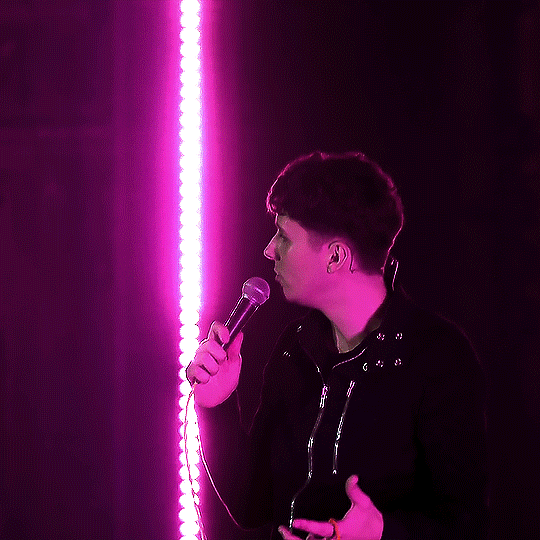
When someone is not versed in theatrical directing, if the audience cannot tell what was a choice by the director or even consider the director themselves, this is weirdly a good sign. It means that it feels natural to what they are witnessing and to the messages that are meant to be communicated to the audience. As someone who also works in government, it feels very similar, as only bad work is evident to the general public. Obviously that is not true for everyone, but is an overall trait I think impacts both an understanding of public service and directing.
I am not familiar with any of the work of Ed Stambollouian, who through research, looks like he has done work with comedians like Joe Lycett (who I am also not familiar with) and directed TATINOF, but also more stripped down, exploratory theatre. Through a quick review of his portfolio, one, I am not shocked that Dan tapped him to assist with directing since there is a familiarity and two, his background tells me he knows how to direct for writer-performers, which is what comedians really are at the end of the day.
To direct for those who are doing one-person shows that they both wrote and performed, it is especially tricky to have the artist hand the reins over to the director. The director in this case acts as the artist’s eyes, because an artist cannot clone themselves. It is impossible for them to wear multiple hats at once, where they can give quality, objective feedback to themselves while also doing a full out performance. For Ed to be someone Dan has worked with before, there is already an established understanding of each other’s work styles, and a trust that otherwise would have to be built up before the work can truly begin to finalize the piece.

In short, Ed Stambollouian and the creative team on We’re All Doomed did an incredible job bringing what I understand Dan intended when he started writing this down in isolation. And @danielhowell you whole-heartedly deserve to call this your magnum opus. What can I say (sorry I can't help lovingly poking fun at you), your artistry shines throughout the show. I hope this too can be something your future self can turn back to.
🧡

(bonus) Thoughts on Orange Carpet & the Phil element
I didn’t fully rewatch the orange carpet, just to keep myself on task & not bring Phil too much into the main reflection without explicit reference in the show, but hearing Dan go “I’m alive in 3, 2…” made me laugh both times. He understands that we just want to know he has a pulse, ya know? Also them pretending it totally was live, when those fools (affectionate) cannot run a real live broadcast from their home for their lives. It just ran too smoothly, esp. in the transitions, for it to be anything but some very, very light editing on one improvised take they did. But I always support them in their acting, no matter how bad, like with DITL Australia’s opener or pretending there were not two apartments or that Google Feud being back was unplanned or Dil being pregnant with a statistically rare alien child or Phil living in a tiled, cramped bedroom or...
Also, Dan’s little laugh at the end of Phil’s sign-off is so fond it hurts. It also hurt that the VOD was hard to scrub through, so another deduction for the Kiswe platform.
Anyway, I’m glad that Dan was able to find space outside of the Dan & Phil branding of the 2010s as well as the image he was forced to manufacture for his YouTube presence, but also realize that with having a core audience that wants him to simply be happy, he can recognize that Phil is part of the things that make him happy. And can do so openly.
He is his own person, but it has been clearly emphasized now that Dan has no interest in not acknowledging that Phil always is and will be part of his present and future. He has made work like WAD & "Gay and Not Proud" to explore his way of thinking without the support of Phil present in the filmed/performed aspect. Dan acknowledges this intention, which is evident with him shooing away Phil at the beginning of “Gay and Not Proud” to process it alone.

It is also evident with the ending of “Daniel & Depression” and the WAD end credit of remote crisis manager showcasing the caretaking role Phil often plays in Dan’s life. But we know that caretaking is reciprocal, considering Phil's tactics with glue as well as his continuing health issues and anxieties. Dan has seen who he is without Phil by his side everyday in the public eye & has no interest in maintaining that Phil is absent for public projections.
I obviously do not know Dan Howell, or anything about him outside what exists on the internet. But in performance studies, there is a foundational understanding that there is no way to not be performing in some way during your day-to-day. Performing is not inherently a bad thing, as there are different roles you take on in your life, where how I engage at work is different from how I am hanging out with friends. This also has basis in gender studies, such as ideas that you can perform your gender "wrong". What has been so interesting to me in this phandom renaissance is the way Dan and Phil each perform as themselves in front of the camera now. What they share out and the layers they include--or choose to not remove--have been stated by them explicitly to be the most authentic they have ever been, without obviously removing their right to privacy. During the height of the glass closet that was their 2018 content, I remember thinking that it was going to be the most they would show us in the vain of "if you know, you know, and we know who will know". After the coming out videos of 2019, obviously that's not true, but the return of dapg has signaled a message of "we know you know, if you've been in the know" while veiled in a way that is not immediately perceivable by those who are casually engaging with their content. It is an authentic portrayal of themselves without filter, while also providing themselves space to not have to announce everything to the world. When you are in the know, it definitely targeted and causes psychic damage, but I am ready for anything and everything they throw our way.
#we’re all doomed#wad spoilers#daniel howell#danisnotonfire#dnp#dan and phil#dan howell#theatre analysis#performance studies#theatre director
77 notes
·
View notes
Text
Damien Rice Launches New American Tour at Kings Theatre
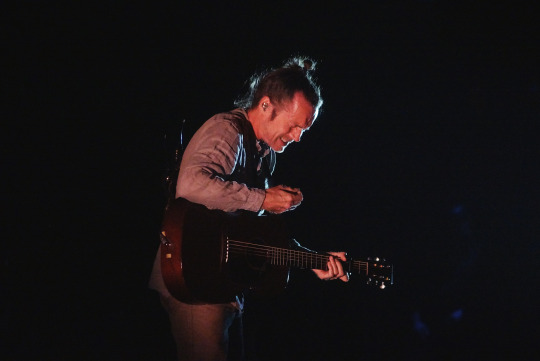
Damien Rice – Kings Theatre – November 29, 2023
I’ve followed the Irish troubadour Damien Rice for years and if you have the chance to see him live it is highly recommended. He creates an intimacy that’s often unmatched by other singer-songwriters, and it’s this talent that has the likes of Ed Sheeran and Niall Horan claiming his influence. Although he hasn’t produced much music since 2014’s My Favourite Faded Fantasy, the often reclusive artist released a haunting cover of Sia’s “Chandelier” in 2021 and more recently 2022’s “Songs for Berta,” a collaboration with Sandrayati and JFDR to honor Honduran environmental activist Berta Cáceres. Rice spent the summer touring Spain and Italy by sailboat, and now he’s in the United States for a short tour that kicked off at a sold-out Kings Theatre on Wednesday night.
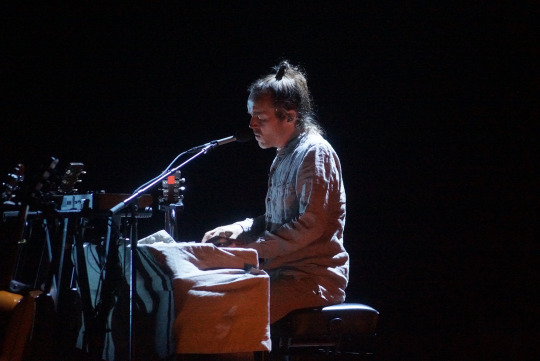
The stage was lit with floor lamps, enshrouding the singer in shadows as he moved to the edge of center stage to tell a tale of 13-year-old boy who must navigate the world of temptation. In true balladeer fashion, the story led into an introduction of “The Professor & La Fille Danse,” from the 2004 B-Sides release. Rice mostly pulled material from his debut album, O, and its follow-up, 9. Former longtime collaborator Lisa Hannigan had an unmistakable stamp on those albums with her supporting vocals, but last night the Brazilian cellist Francisca Barreto beautifully filled those singing duties on “Volcano” and “9 Crimes.”


Between songs, Rice shared stories and musings on life and music, describing the latter as an “emotional toilet,” wherein the rotten feelings are released and (hopefully) processed into positivity. The singer-songwriter hadn’t prepared a setlist so he fielded an endless stream of song requests, which led to playing the rare track “Insane.” Toward the end of the performance, Rice encouraged fans to rise from their seats and get closer to the stage while he strummed the upbeat “Coconut Skins” and shared the new song “Behind Those Eyes.” After a brief exit, Barreto and Rice returned to encore with “Cold Water” against a vibrant blue illumination to their background. Fearing the show’s real conclusion, fans shouted for more songs leading to Rice rocking out on “I Remember” as flashing floor lamps pulsated before fan-favorite “The Blower’s Daughter” sent everyone off into the cold, humming into the night. —Sharlene Chiu | @Shar0ck
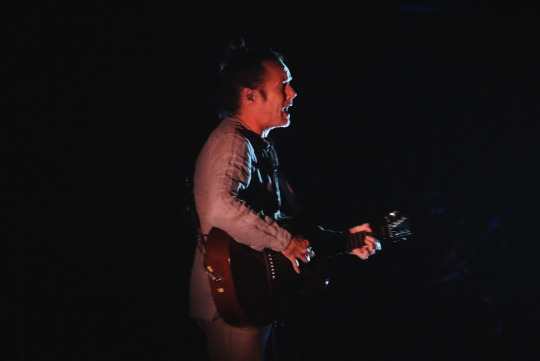
Photos courtesy of Ken Grand-Pierre | www.kenamiphoto.com
#B-Sides#Berta Cáceres#Bowery Presents#Brooklyn#Damien Rice#Ed Sheeran#Flatbush#Francisca Barreto#Ken Grand-Pierre#Kings Theatre#JFDR#Lisa Hannigan#Live Music#Music#My Favourite Faded Fantasy#New York City#Niall Horan#Photos#Review#Sandrayati#Sharlene Chiu#Sia
4 notes
·
View notes
Text
Broadway's Newest Comedy Has The Juice (And I Can't Imagine a More Beautiful Thing)

View On WordPress
#broadway#broadway musical#broadway musical review#broadway show#Broadway theater#broadway theatre#live entertainment#musical#musical review#new musical#new york#New York city#NYC#show#shucked#theater#theatre
4 notes
·
View notes
Text
News Resources For Keeping Up With The Arts
Art
🎨 Apollo Magazine
🎨 Artnet
🎨 The Art Newspaper
🎨 Artsy
🎨 Hyperallergic
Ballet
🩰 The Ballet Bag
🩰 The Ballet Herald
🩰 Ballet News
🩰 BBC News - Ballet
🩰 Critical Dance
🩰 Dance Europe
🩰 Pointe Magazine
Classical Music
🎻 Bachtrack
🎻 BBC Classical Music Magazine
🎻 ClassicFM
🎻 Musical America Worldwide
🎻 Naxos
🎻 The Strad
Fashion
👠 British Vogue
👠 Business of Fashion
👠 The Cut - Fashion
👠 Fashionista
👠 Fashion Magazine
👠 Fashion Week Online
👠 Harpers Bazaar
👠 Refinery29
Film
📽 Cinema Scope
📽 Criterion
📽 Deadline
📽 Film Comment
📽 Film Noir Foundation
📽 The Hollywood Reporter
📽 IndieWire
📽 MUBI
📽 RogerEbert.com
📽 Screen Daily
📽 Sight and Sound
📽 Silent Era
📽 Slash Film
📽 Variety
📽 The Wrap
Jazz
🎷 All About Jazz
🎷 DownBeat
🎷 Jazz In Europe
🎷 Jazz FM
🎷 Jazz Near You
🎷 Jazz Times
🎷 JazzWise
🎷 WBGO
Kabuki and Noh Theatre
🎎 Japan Arts Council
🎎 Kabuki21
🎎 Kabuki Official Website
🎎 The Noh
🎎 Nohgaku
🎎 Noh Society
Literature and Poetry
📚 BookPage
📚 Electric Literature
📚 The Guardian - Books
📚 The Kenyon Review
📚 Literary Hub
📚 The Millions
📚 The New York Times - Books
📚 NPR Books
📚 The Paris Review
📚 Poems.com
📚 Poets.org
📚 PoetryFoundation.org
📚 The Poetry Society
📚 Publishers Weekly
Opera
🏛 BBC News - Opera
🏛 The Guardian - Opera
🏛 Opera News
🏛 Opera Today
🏛 Operawire
🏛 Parterre Box
Theatre
🎭 Broadway News
🎭 New York Times - Theatre
🎭 Playbill
🎭 The Stage
🎭 Theatre Weekly
#masterpost#art#classic art#classic academia#light acamedia#dark academia#opera#theatre#kabuki#kabuki theatre#noh#noh theatre#ballet aesthetic#ballet#balletcore#classical music#media#resources#it girl#that girl#chic#messy french girl#jazz#fashion#classic hollywood#old hollywood#stardust swan#prissy girl#dream girl journey#high maintenance
481 notes
·
View notes
Text
ROMEO & JULIET REVIEWS
Stage to Page - 5/5
The Telegraph - 5/5
London Theatre - 4/5
Broadway World - 4/5
Evening Standart - 4/5
Financial Times - 4/5
Daily Mail - 4/5
Time Out - 4/5
Whats On Stage - 4/5
The New York Times - No score, but it looks like a 3/5
Gay Times - 3/5
The Guardian - 3/5
The Stage - 3/5
The Times - 3/5
iNEWS - 3/5
Theatre Weekly - 3/5
BBC - 2/5
The Independent - 2/5
Daily Express - 1/5
Overall positive, a mixed reaction of sorts with people complaining on Jamie Lloyd's style being too stripped down. Expected. Tom and Francesca receiving rave reviews all around and a lot of publications loved the whole thing. Happy! :)
53 notes
·
View notes